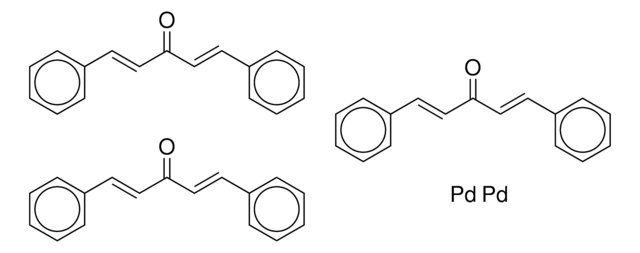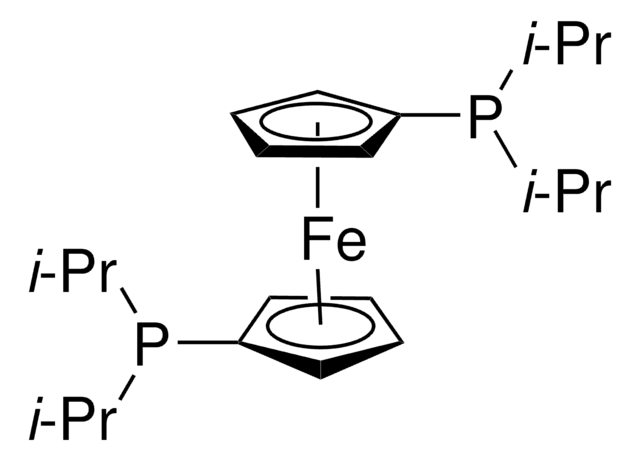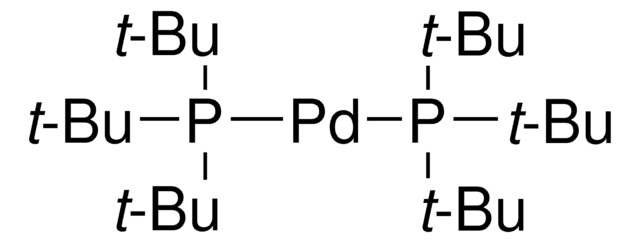701602
[1,1′-Bis(di-tert-butylphosphino)ferrocene]dichloropalladium(II)
98%
Synonym(s):
PdCl2(dtbpf)
About This Item
Recommended Products
Assay
98%
form
powder
reaction suitability
core: palladium
reaction type: Buchwald-Hartwig Cross Coupling Reaction
reaction type: Cross Couplings
reaction type: Heck Reaction
reaction type: Hiyama Coupling
reaction type: Negishi Coupling
reaction type: Sonogashira Coupling
reaction type: Stille Coupling
reaction type: Suzuki-Miyaura Coupling
reagent type: catalyst
greener alternative product characteristics
Catalysis
Learn more about the Principles of Green Chemistry.
sustainability
Greener Alternative Product
mp
203-208 °C
greener alternative category
, Aligned
storage temp.
−20°C
SMILES string
[Fe].Cl[Pd]Cl.CC(C)(C)P([C]1[CH][CH][CH][CH]1)C(C)(C)C.CC(C)(C)P([C]2[CH][CH][CH][CH]2)C(C)(C)C
InChI
1S/2C13H22P.2ClH.Fe.Pd/c2*1-12(2,3)14(13(4,5)6)11-9-7-8-10-11;;;;/h2*7-10H,1-6H3;2*1H;;/q;;;;;+2/p-2
InChI key
JQZFOBWXNREQLO-UHFFFAOYSA-L
Looking for similar products? Visit Product Comparison Guide
General description
PdCl2(dtbpf) is an air-stable cross-coupling catalyst used in the Suzuki coupling of various aryl chlorides.
Application
It is also employed as catalyst for greener Suzuki cross-coupling in TPGS-750-M.
On the Way Towards Greener Transition-Metal-Catalyzed Processes as Quantified by E Factors
Storage Class Code
11 - Combustible Solids
WGK
WGK 3
Flash Point(F)
Not applicable
Flash Point(C)
Not applicable
Personal Protective Equipment
Choose from one of the most recent versions:
Already Own This Product?
Find documentation for the products that you have recently purchased in the Document Library.
Customers Also Viewed
Articles
TPGS-750-M, a second generation surfactant, is useful for room temperature, palladium and ruthenium-catalyzed reactions in water. Reactions include the Heck reaction, Suzuki-Miyaura reaction, Sonogashira reaction, Buchwald-Hartwig amination reaction, Negishi reaction, and olefin metathesis.
The Heck reaction is the palladium catalyzed cross-coupling reaction between alkenes and aryl or vinyl halides (or triflates) to afford substituted alkenes.
Protocols
TPGS-750-M, a second generation surfactant, may be used for Suzuki-Miyaura Reactions in Water at Room Temperature
Our team of scientists has experience in all areas of research including Life Science, Material Science, Chemical Synthesis, Chromatography, Analytical and many others.
Contact Technical Service![[1,1′-Bis(diphenylphosphino)ferrocene]dichloropalladium(II)](/deepweb/assets/sigmaaldrich/product/structures/130/734/8846aa26-1858-458a-998d-8c306c13bf0f/640/8846aa26-1858-458a-998d-8c306c13bf0f.png)


![[1,1′-Bis(diphenylphosphino)ferrocene]dichloropalladium(II), complex with dichloromethane](/deepweb/assets/sigmaaldrich/product/structures/825/986/4317978b-1256-4c82-ab74-6a6a3ef948b1/640/4317978b-1256-4c82-ab74-6a6a3ef948b1.png)









